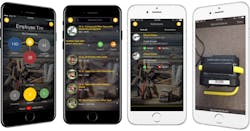Sponsored Content
If you’re like most contractors, you’ve invested a lot of money to ensure that your teams have the required tools for completing jobs. However, despite these large investments in tool assets, you might not be tracking their usage and location like you do with your big machinery. We get it—you understand it’s important to track all the assets, but managing smaller tools is sometimes overlooked because it takes time to do it. And you’re not alone. According to our tool-tracking survey, 50% of contractors have given up tracking small tools and equipment.
Why aren’t contractors tracking tools? The primary reason actually lies within accounting policies. Most financial people start capitalizing assets at a level that excludes the value of most tools, so tools end up being expensed. On the surface, it makes sense that if tools are expensed, they aren’t listed as fixed assets and are therefore treated as consumables. But the reality is: the lifespan of a tool could be several years or more. So perhaps those tools should be accounted for like other pieces of typically more expensive equipment.
But how?
How can contractors effectively and affordably track tools at the enterprise level? We’ve heard numerous times that keeping track of tools on an Excel spreadsheet simply doesn’t work
—especially when it comes to accountability regarding who had a certain tool last. Many contractors realize that just having a tool inventory record doesn’t solve all tool management issues. Fortunately, new tool-tracking software allows you to manage your inventory from your cell phone.
A Comprehensive Tool Inventory
Tracking and managing your company’s large investments in tools means getting organized in a new, more efficient way—and with modern technology, it is completely doable. Tool-tracking solutions like ShareMyToolbox let employees know which tools are available and which coworker has them without needing to call the office for that information. Unlike a static check-in, check-out list, this type of app holds employees accountable for the tools assigned to them, and facilitates the exchange of tools between employees without checking them back into a tool crib.”
Here’s how it works:
- Know what tools you currently have (and how long you’ve had them).
First, compile a current inventory of all of the tools and equipment you own. It’s also important to track how long you’ve owned them so that you can anticipate necessary maintenance or replacement and whether your equipment is lasting as long as it should be. - Know their current location.
Tools and equipment move in the field—that’s part of what makes tracking them a challenge. But you’ll need to look at the list of what you currently own and answer the question: right now, where is it? This will also help reveal which tools are sitting idle and therefore available for use on other jobs. - Know who’s responsible.
Responsibility must be assigned to the person currently using a tool; and this person must be able to not only accept this responsibility, but to also transfer it. It’s been proven time and time again: having a system that enables personnel to carry out and track tool transfers in the field places a more urgent sense of responsibility on field personnel. You will reduce tool loss when everyone knows who is accountable for each tool.
Not accounting for the smaller tools and equipment that continually vanish from your job sites means thousands of dollars vanish right along with them. It’s time to consider an easy-to-use tracking system to keep an eye on those assets that fall below the capitalization threshold. Whether you’re trying to build your own process or evaluating a tool tracking system, be sure it starts with getting organized.
To learn more about tool tracking technology that helps you easily organize a comprehensive tool inventory, visit www.sharemytoolbox.com/tool-tracking.
Additional available articles on this topic include:
Asset Capitalization & Tool Tracking



